|
Social
News 27/6
Bangladesh paper supports Vietnam’s cyber security law

Lawmakers press buttons
to adopt Law on Cyber Security
Bangladesh’s Dhakatribune newspaper recently published
an article showing strong arguments and proof regarding the US to support
Vietnam’s Law on Cyber Security, saying that the law will bring more
jobs to Vietnam and stronger commitment from investors which would help
stabilise growth for the country.
About the line between cyber security and privacy
right, the article disagrees with the opinion that the law is set to restrict
Facebook and Google, hurt investors’ confidence and stunt the growth of
Vietnam’s digital economy, given that it requires Vietnamese data to be
stored within the country and allow the government full access as part of
security measures.
It cited the example of the US, saying that there has
been a much more robust government surveillance system in place under its
Patriot Act, in the aftermath of the 9/11 terrorist attack and anthrax
attack. The internet and Big Data-related businesses expanded, while the
general masses in the US lived under their government’s active and
heavy-handed surveillance.
Vietnam is an independent country and its legislatures
have the right to get a better understanding of their citizens’ data in order
to protect their national interests, it said, adding that Vietnam is simply
exercising its right to protect their citizens from any possible
manipulation.
According to the article, Europe has an extensive cyber
security policy, and both Facebook and Google are currently negotiating with
the EU to settle the damage they have dealt.
The new regulation will require these companies, who
will continue to operate in Vietnam, to open offices in Vietnam and abide by
the laws of the land (including storing data in their soil and to hand over
any required access to government authorities).
In conclusion, the article welcomed the new regulation
which it said, will actually render additional businesses and services free
from possible manipulation.
HCM City, Finland discuss smart urban development
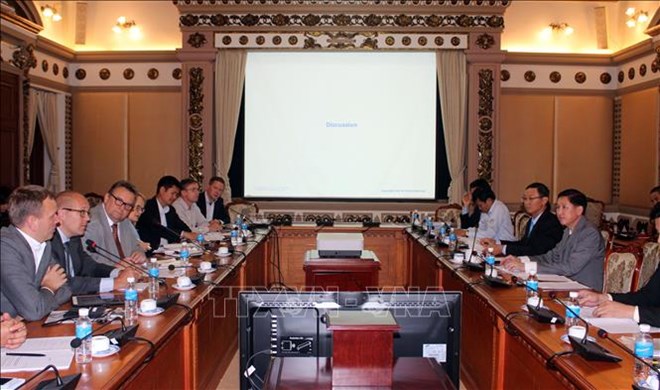
At the working session
Ho Chi Minh City wants to receive support from domestic
and foreign resources in smart urban development, said Vice Chairman of the
municipal People’s Committee Tran Vinh Tuyen.
During a working session in the city on June 26 with a
delegation of Finnish experts in smart urban development and innovation led
by Ambassador of Finland to Vietnam Kari Kahiluoto, Tuyen said the city is
keen on fields of Finland’s strength such as smart health care and transport
development, and sport management.
He added that the city’s smart urban development
project aims to put its economy on rapid and sustainable growth path, create
a close interaction between authorities and people to bring practical and
long-term benefits to them.
Ambassador Kahiluoto, for his part, said leading
Finnish experts in smart urban development and innovation area are ready to
share experience and want to establish long-term cooperation with the city in
the field.
Finland wants to foster ties with the city to build
smart urban development initiatives, provide solutions to projects in smart
urban transportation, community-based health care and clean energy, he
said.
He promised that Finland will attend an international
conference on calling for investment in sub-components of the smart urban
development project scheduled for this July as invited by the city
authorities, adding that Finnish firms and experts will recommend specific
technical solutions at the event.
Finnish experts introduced several outstanding smart
urban and innovation park building projects abroad, technical requirements
for the process.
They also expressed readiness to transfer technological
advances and finance to the city in the effort.
International organisations help Vietnam in tobacco
prevention
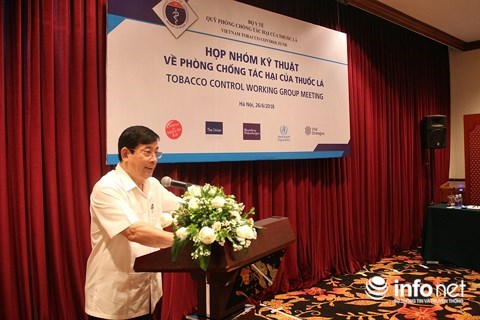
Luong Ngoc Khue, director
of the Vietnam Fund for the Prevention of Tobacco Harms
Vietnam’s Health Ministry and the Fund for the
Prevention of Tobacco Harms on June 26 held a meeting of the tobacco control
working group, gathering representatives from key tobacco control
organisations in Vietnam and its development partners.
The meeting was attended by Head of the Bloomberg
Philanthropies Public Health Programme Kelly Henning, and experts from the
HealthBridge Foundation, World Health Organisation, Vital Strategies
organisation and Chicago University, among others.
Luong Ngoc Khue, director of the Vietnam Fund for the
Prevention of Tobacco Harms, said Vietnam has built a network on the
prevention of tobacco harm in all 63 provinces and cities. The localities
have built non-smoking areas and the cities of Ha Long, Hue, Nha Trang and
Hoi An are developing smoke-free tourism areas.
Khue said about 1,200 secondary and high schools and
nearly 130 colleges and universities nationwide have banned smoking.
However, he noted that at present, nearly half of
Vietnamese men smoke, a high figure he said that needs to be reduced.
At the meeting, experts discussed the enforcement of
the Law on the Prevention and Control of Tobacco Harms in Vietnam, including
increases in tobacco prices and import duties, inspections and punishment of
violations in the implementation of a smoke-free environment and Vietnam’s
Programme on Tobacco Prevention and Control.
According to Health Minister Nguyen Thi Kim Tien,
tobacco costs Vietnamese smokers 31 trillion VND (1.36 billion USD) per year.
Treatment for five major diseases - lung cancer,
gastrointestinal-respiratory cancer, chronic obstructive pulmonary disease,
heart attacks and strokes, caused by smoking, are estimated to cost 24
trillion VND (1.05 billion USD).
Multi-million dollar plan to prevent child drownings

Nguyễn Thị Hà, Vice Minister of Labour, Invalids and Social Affairs
(MOLISA) said that nine children die from drowning every day in Việt Nam.
A new scheme aimed at preventing children from drowning
was launched on Monday in the capital city.
Kelly Henning, director of Bloomberg Philanthropies’s
Public Health Programmes, announced a commitment of US$2.4 million for the
first two years of the five-year programme.
The programme will focus on proper supervision of
children under five years old, and survival swimming lessons for those aged
from six to 15 years old.
It will also raise awareness about risk factors and
preventive measures, and strengthen co-ordination among relevant agencies in
Việt Nam.
Drowning was a ’silent epidemic’ that claimed the lives
of more than 2,000 children each year in Việt Nam, making drowning the
country’s leading cause of child deaths under 15, according to Nguyễn Thị Hà,
vice minister of Labor, Invalids and Social Affairs.
The rate of child drowning in Việt Nam is higher than
in other Southeast Asian countries, and 10 times higher than in some
developed countries.
“Việt Nam has undertaken significant efforts to prevent
child drowning, including adopting a strong legal framework,” said Hà.
“Following close co-ordination among relevant
ministries and social organizations, and with the support of national and
international organizations, we can all contribute to securing a safe
environment for our children.”
The programme will begin with targeted support for
local governments and communities in the provinces of Lào Cai, Yên Bái, Ninh
Bình, Quảng Bình, Thanh Hóa, Đắk Lắk, Đồng Tháp and Sóc Trăng.
New bus station on Belt Ring Road No.3 illogical:
experts
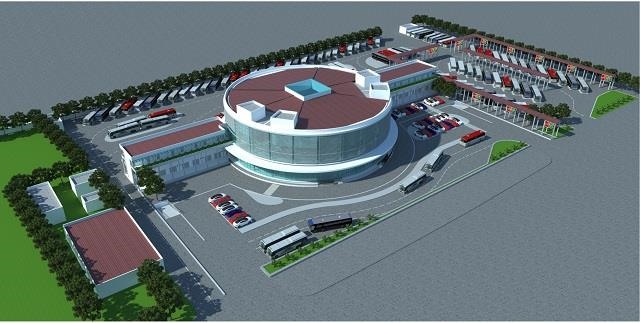
Artist’s impression of Yên Sở’s new bus station, planned for Belt
Ring Road No.3 in Hoàng Mai District. – Photo kinhtedothi.vn
The recent decision of the Hà Nội People’s Committee to
approve the construction of a new bus station on Belt Ring Road No.3 is
contrary to the city’s prior plans to remove bus stations from the inner
city, transport experts say.
The new bus station, to be called the Yên Sở station,
will be built on Belt Ring Road No.3 near Yên Sở Park in Hoàng Mai District,
reported online newspaper vietnamplus.vn.
Hà Nội plans to transform four major inter-provincial
bus stations in the inner city, including Gia Lâm, Mỹ Đình, Giáp Bát and Nước
Ngầm, into car parks and inner-city bus interchanges by 2020. The changes are
part of the draft plan to improve parking lots, bus stations and bus
interchanges by 2030. By moving the major inter-provincial bus stations
outside of the central city, urban planners hope to reduce heavy traffic that
currently ensnares commuters around the stations.
Gia Lâm and Giáp Bát bus stations are to be turned into
parking lots by 2020 with Mỹ Đình and Nước Ngầm following five years later.
Notably, the Yên Sở station is just 1km away from the
current Nước Ngầm bus station.
“Building Yên Sở bus station is contrary to the plan of
moving bus stations out of the inner city. That plan should not be done by
half”, said Nguyễn Văn Thanh, president of Việt Nam Auto Transport
Association.
“The city might not attract private investment into the
new stations in the outlying areas, as is the plan if Yên Sở station is
built”, he said.
Funds to construct the bus station amount to VNĐ118
billion (US$5.1 million), of which investor’s capital is VNĐ30 billion
(US$1.3 million), accounting for 25.4 per cent. The rest was loaned and
mobilised from other sources.
The Yên Sở Station is to be built on an area of 3.2ha.
It will be used for coaches and trucks during the coming transitional period
as officials construct new bus stations outside of the city. Yên Sở station
will have a capacity of 800-1,000 fixed-route coaches and 200 trucks daily.
Although it is meant to be a temporary station, the
city has granted an operating license of 50 years.
Bùi Danh Liên, president of the Hà Nội Transport
Association agreed with Thanh’s criticisms.
“Building Yên Sở station is illogical. It is too small
to share the overload of Nước Ngầm station”, he said. “And removing the
current stations which were operating well was non-sense”.
The ground clearance for Yên Sở bus station has not
been completed due to protests by local residents.
Other transport experts also disagreed with the city’s
plan to remove the current bus stations from the inner city.
The draft plan claims new bus stations in the Belt Road
No.4 area are more convenient for passengers to travel inter-province routes
and will help ease traffic congestion in the inner city.
“But that plan is contrary to trend in the world,
especially in European countries, where they place key bus and metro stations
in the inner city”, said Nguyễn Xuân Thủy, a transport expert and former of
director of Transport Publishing House.
According to Thủy, building new bus stations on Belt
Ring Road No.4, which is 10-20km from the inner city, would cause
inconvenience and a higher cost of transport for passengers.
Moreover, traffic congestion would actually worsen if
everyday thousands of bus riders are moving to and from the inner city and
suburban areas.
“Removing the current bus stations from the city will
cause losses of billions of đồng because the stations have already received
much investment, never mind the cost of using the land to construct new
stations”, Thủy told the paper.
The city’s weak urban and transport planning is
contributing to its terrible traffic congestion at present, said Thủy.
For southern farmers, mangosteen no longer pays
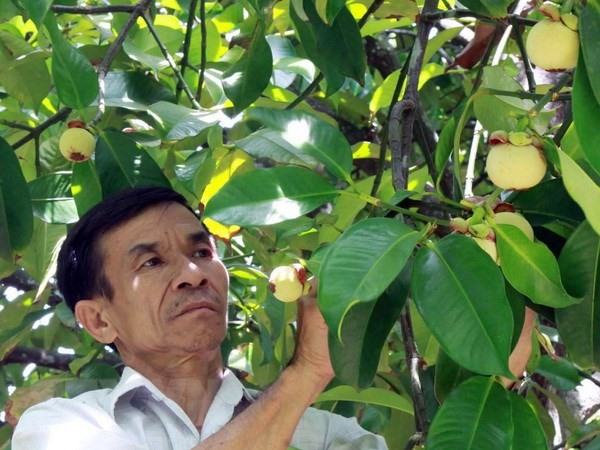
A farmer in Bến Tre Province in the Cửu Long (Mekong Delta) tends to
his mangosteen tree.
Though he has grown and sold mangosteen fruit for 20
years, Lê Văn Sơn of the Bến Tre Province in the Cửu Long (Mekong) Delta has
gradually removed the trees from his orchard over the last two years.
The 0.6ha formerly filled with mangosteen has been
replaced by durian and mango trees on his 1.2ha orchard in Chợ Lách District.
Sơn said he made the right choice.
“I used to make VNĐ15 million (US$655) a year selling
mangosteen fruit. But crop failures in the past three years halved my
earnings from the fruit to only VNĐ7 million ($306) per year,” he said.
Having earned VNĐ1 billion ($44,000) from selling
fruits from 100,000 durian and mango trees in the past two years, Sơn said he
might get rid of his mangosteen trees altogether.
“Mangosteen has helped put food on our table for a long
time, but it seems to have become outdated,” he said. “I’m thinking of
removing all the mangosteen trees from my orchard.”
Many farmers in Bến Tre Province have stopped growing
mangosteen due to its low economic efficiency, though the fruit being one of
the province’s five fruit specialties, Thanh Niên (Young People) newspaper
reported.
A historic saltwater intrusion that affected the
province in 2016 is blamed for the situation.
“Our mangoteen crops kept failing after that,” said Nguyễn
Văn Thùy, a farmer in the province’s Vĩnh Hòa Commune. A month ago he decided
to cut off 3,000sq.m of mangoteen trees that he had been growing for 30 years.
“I couldn’t take it anymore and decided to switch to
growing flowers,” Thùy said.
Switching from mangosteen to other types of fruits and
flowers causes farmers trouble because they are not familiar with the new
crops and unsure who to sell them to.
But since mangosteen takes about five years to bear
fruit, the farmers’ decision is basically irreversible. It would take years
before they can start earning money again, if they want to get back into the
mangosteen business.
Trademark infringement is another factor that
discourages farmers from growing mangosteen. For a long time, Bến Tre
Province has been known for its Cái Mơn fruit brand, but more fruit products
from other localities have been snuck into the province and fraudulently sold
under the brand.
“We all know that our mangosteen growing area and
yields have been decreasing. But when the mangosteen season comes, the fruit
is sold everywhere at a cheaper price than what we normally offer,” said
mangosteen grower Bùi Văn Công of Long Thới Commune.
“This is why we gave up on the hope of having an
authentic mangosteen brand,” he said.
The province’s agricultural authorities seem unsure how
to deal with the situation. No measures have been applied to improve soil
quality since the 2016 saltwater intrusion.
The province had 1,600ha of mangosteen growing area in
2014, and it’s been on the decline ever since, said Võ Văn Nam, manager of
the Cultivation and Plant Protection Division under Bến Tre Province’s
Department of Agricultural and Rural Development.
“This affected the province’s strategy of developing
five fruit specialties, including durian, rambutan, green-skin pomelo, longan
and mangosteen,” he said.
Bùi Thanh Liêm, director of the agricultural division
of Chợ Huyện District, said that it is hard for mangosteen to survive
saltwater intrusion and the extreme weather conditions that the Mekong Delta
experienced in recent years, which caused a drastic reduction in mangosteen
yields.
“Considering the profits farmers have been making from
selling other types of fruits and flowers, it is understandable that they
stopped growing mangosteen,” he said.
“We find it hard to maintain the remaining mangosteen
growing area, let alone consider increasing it,” he said.
Cao Bằng to host song and dance fest

Artists from Cao Bằng Art Troupe perform on stage. The National Song
and Dance Festival will gather 12 troupes from northern provinces between
June 29 and July 7.— Photo bienphong.com.vn
Hundreds artists of 12 art troupes from northern
mountainous provinces will take part in a national song and dance festival in
Cao Bằng Province between June 29 and July 7.
Participants include troupes from Điện Biên, Sơn La,
and Lào Cai, as well as Yên Bái and Tuyên Quang.
The opening ceremony and music show, which will be
broadcast live on VTV channel, will take place at 8 pm on June 29 at the Cao
Bằng Provincial Conventional Centre.
The closing ceremony will take place on July 27 at 8pm.
The opening and closing shows will feature the most
distinguished performances from participating troupes.
During the festival, the troupes will perform before a
local audience, while three troupes will tour Cao Bằng City and other
districts such as Trùng Khánh and Hà Quảng..
Organisers said the event is an opportunity for
professional art troupes and artists to engage in cultural exchange and for
young talents to shine. The event also aims to encourage art troupes to stage
high quality performances to entertain audiences.
GEF 6 side event calls for joining hands to protect
ocean
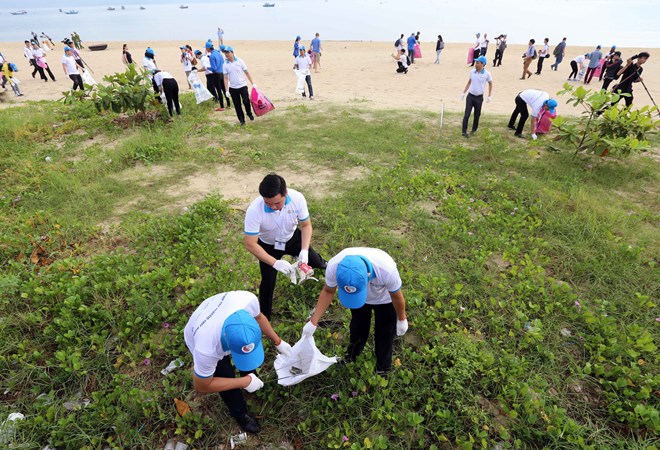
Participants in the
“Joining hands to protect the ocean” programme clean up a beach in Da Nang
city
Vietnam’s Ministry of Natural Resources and Environment
(MoNRE) organised a programme titled “Joining hands to protect the ocean” in
the central coastal city of Da Nang on June 26 in response to one of the
themes of the 6th Assembly of the Global Environment Facility (GEF) which is
taking place in Da Nang.
Addressing the programme’s launch, MoNRE Deputy
Minister Vo Tuan Nhan said the increasing volume of trash, especially plastic
oceanic waste, is threatening the beauty of Da Nang, which has won numerous
titles such as the best city for living in Vietnam or one of the most
favourite destinations in the world in 2015.
He stressed that plastic trash has become a big threat
to the world’s oceans in general and Vietnam’s seas in particular, calling on
ministries, agencies, local administrations, organisations, businesses and
individuals to join hands with the Natural Resources and Environment sector
to carry out regular and effective campaigns to clean up the beaches, thus
preserving the marine environment.
Under Secretary-General of the UN and Executive
Director of UN-Habitat Maimunah Mohd Sharif told the event that marine
pollution is one of the biggest concerns nowadays, which is worsening at a
pace unseen before due to waste from industrial and agricultural production
as well as daily life.
She cited statistics of the World Economic Forum that
around 8 million tonnes of plastic waste were discharged into the ocean every
year, while 3 billion people around the world rely on the ocean for their
livelihoods.
Therefore, it is necessary to raise people’s awareness
about marine trash and community responsibility in managing and protecting
the marine environment.
The UN Under Secretary-General stressed that
preservation and sustainable use of the ocean and marine resources as one of
the Sustainable Development Goals set by the UN. She pledged to cooperate
with and support Vietnamese partners, especially the MoNRE, in combating
marine pollution.
Executive Coordinator of UNDP Global Environmental
Finance Adriana Dinu said with 3,000 km of coast, Vietnam contributes to and
also is affected by marine plastics. She stressed that with 20 percent of its
GDP comes from marine resources, Vietnam must take necessary measures to
protect and restore the ocean.
After the launch, more than 600 delegates, young people
and local residents collected trash and cleaned up the beaches, and planted
trees.
The 6th GEF Assembly is taking place in Da Nang from
June 23-29.
Children in Phu Yen receive free screenings, surgeries
for facial deformity
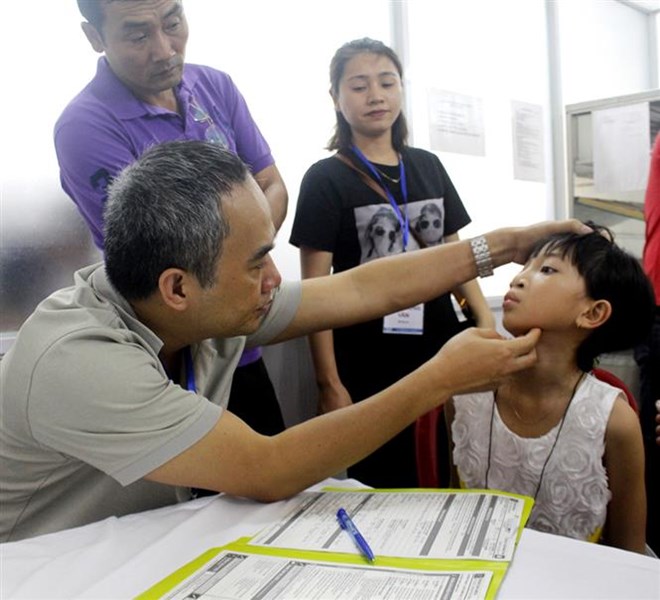
Doctor provides checkup
for a child patient
A programme providing free screenings and operations
for children with cleft lip, cleft palate was held at the General Hospital of
the central coastal province of Phu Yen from June 22-26.
It was organised by the 108 Military Hospital of the
Ministry of Defence, doctors and volunteers from the Operation Smile
organisation of the Republic of Korea and the provincial Department of
Labour, Invalids and Social Affairs.
Many children in Phu Yen as well as neighbouring
provinces of Khanh Hoa, Binh Dinh and Dak Lak received medical checkups at
the programme, the first of its kind held in Phu Yen province.
After medical checkups and screenings, 100 children
will receive free surgeries and treatment. The programme also supports
travelling and accommodation fees for the patients.
Nearly 300 children in Phu Yen with cleft lip and cleft
palate have received medical checkups since 2008, and among them, 200
received free surgeries sponsored by donors found by the provincial Fund for
Children.
Some 2,000 babies are born with cleft lip and cleft
palate every year in Vietnam.
Since 1994, the National Fund for Vietnamese Children
(NFVC) has run the Operation Smile programme to provide cleft lip and cleft
palate surgeries for children. To date, nearly 30,000 children have benefited
from the programme.
The NFVC has also mobilised resources to provide
post-surgery assistance for children, thus helping them practice
pronunciation and integrate into the community.
Red Journey blood donation campaign returns to Gia Lai
The trans-nation Red Journey blood donation campaign
kicked off in Chu Pah district, the Central Highlands province of Gia Lai on
June 26, with more than 500 officials, cadres, workers and students taking
part.
More than 330 units of blood were collected at the
event.
It has been the third consecutive year the campaign was
launched in Gia Lai, helping to collect donated blood for the treatment of
patients.
Deputy head of the campaign’s organising board Le Hoang
Oanh said hospitals nationwide often lack blood during summer so that the
National Steering Committee for Voluntary Blood Donation holds the annual
campaign to ease the scarce blood supply.
In 2017, nearly 1.5 million units of blood were
collected nationwide, 98 percent of them were from voluntary donors.
Over the past five years, the campaign has come to 46
cities and provinces nationwide, raising public awareness of the effort and
acquiring more than 120,000 blood units.
This year, the drive was scheduled to go through 26
cities and provinces.
VNN
|
Thứ Tư, 27 tháng 6, 2018
Đăng ký:
Đăng Nhận xét (Atom)
Không có nhận xét nào:
Đăng nhận xét